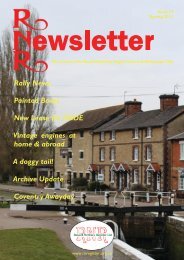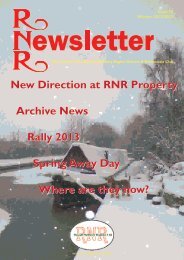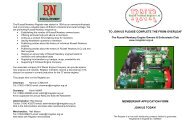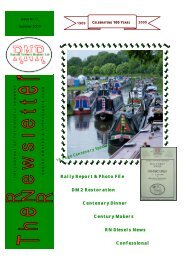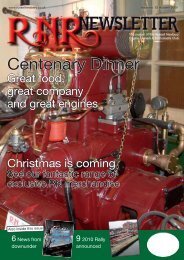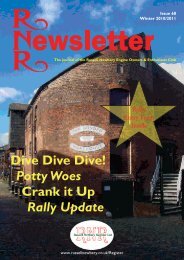Issue 66, Summer 2010 - Russell Newbery Register
Issue 66, Summer 2010 - Russell Newbery Register
Issue 66, Summer 2010 - Russell Newbery Register
- No tags were found...
You also want an ePaper? Increase the reach of your titles
YUMPU automatically turns print PDFs into web optimized ePapers that Google loves.
(MIS) ADVENTURES SO WAS IT DUNKIRK...OR BUST?As mentioned in the Winter Newsletter,we had been planning for nearlyfive years to take Trimilia to Dunkirkfor the 70th Anniversary of the evacuation.So, was it Dunkirk... or was itBust?Unfortunately, on this, our first seriousand hopefully memorable adventurein Trimilia it was Bust. We leftWoodbridge on a fine sunny Sundaymorning, cruising the eight milesdown river to the open sea for the 10hour run to Ramsgate where the 50plus Dunkirk Little Ships were to gatherbefore heading to Dunkirk. Wemade it as far as Felixstowe Ferry,just before the Deben Bar when theengine cut out. No coughing or spluttering...just a complete stop. Anumber of boats in Woodbridge hadbeen suffering from the dreaded dieselbug and although we had onlyjust had new fuel filtersfitted by the Marina we could onlysurmise that this was the cause ofour problem. We switched to back upfilters and as it was too late to returnto Woodbridge we headed for SuffolkYacht Harbour on the River Orwell.We spent two nights there during4which time it was determined that wehad simply suffered from an airlock inthe fuel system.We set out on the morning of a grey,wet and windy Tuesday with the forecastof a force five increasing later toseven. We reached open sea afterthirty minutes .... a force five, beamsea,wind against tide. We managed a'nightmare' forty five minutes, rollinggunnels to gunnels and making littleheadway. Trimilia, with her PDM4,should do eight knots at 1300rpm butthe engine overheats at 900 rpmwhich limits us to a maximum of sixknots, which is simply not enough to'push through' what for us were heavyseas. With the crew in mutiny andwith contents of the boat, includingfurniture that we are unable to stow,crashing about us, the decision wasmade to retreat to Harwich. Whilst inHarwich we picked up a copy of theEast Anglia daily Times to see Trimiliaand our Dunkirk plans as a centrepage photo spread. Embarassing! Wespent two nights on Ha'penny Pier atHarwich before returning, tails betweenour legs, to Woodbridge. Tailsbetween our legs because Anglia televisionhad been to interview us onTrimilia and had featured us on TV onthree nights. They were also due tomeet with us at Ramsgate for a liveinterview. We were also to take aBBCcameraman across to Dunkirk and Iwas supposed to be writing an articlefor National Historic Ships. I think wewere the only Little Ship that failed tomake the event.Oh well! That's boats for you .... Especiallythose that are 85 years old.Only five years until the next, the75th Dunkirk Anniversary and so it'sback to investigating our engine overheatingproblem. Perhaps we can findsomeone who can get it sorted bythen!Oh dear! The best laid plans etc. However,we look forward to readingabout a successful trip in 5 yearstime. [Ed.]JARRETT’S ISLAND Time Travel with a difference . By our special correspondent.It is well known that the passing ofGeological Time is measured in hundredsof thousands or millions ofyears. And those of you who havebeen into the Dudley Tunnel limestonecaves will be aware that wayback in time that part of earth as weknow it was once tropical – and underwater too.In plate tectonics we learn that theearth is made up of many such structures.The earth is constantly in motion– infinitesimally undetectable –that is, until some major change causesan event which is sometimes catastrophic.The San Andreas fault setsoff many small earthquakes in Californiaand is constantly monitored topredict if a major event is about tooccur; the eruption of Mount St Helensin Washington State; the tsunamifollowing the underground volcaniceruption on Boxing Day in the IndianOcean. When continental plates arepushed together they slide above andbelow each other, a phenomenonknown as subduction. The island ofSurtsey off the coast of Iceland wasformed by an enormous underseaeruption which caused so much lavato spew out which solidified as itreached the surface. That was in1963-67. Mount Snowdon in Wales isan extinct volcano but the faults lyingbeneath the UK still produce earthquakeactivity – in June this yearthere were 10 recorded by the BritishGeological Survey – one in the NorthWales area known as the Lleyn Peninsulaon the 30th.No surprises then that prior to theseevents, small subductions may haveoccurred and we believe that thetremor in the Lleyn peninsula mayhave been preceded by a shift in thestrata in the North Western coastalarea lying between Anglesey andMorecambe Bay. Data supplied to theRNR further suggests that the exactsubduction point lay close to a linebetween the Mersey estuary and Runcornand that seismic activity wasrecorded on the 11th June in this area.Although sometimes not felt or seen,it may be the reason why, on 13thJune, a narrowboat travelling in convoyon the Manchester Ship Canalbecame grounded at a point coincidentwith the fault line data. The skipperof this narrowboat and his trustycanine companion came to no harmand in true scientific tradition; thediscovery of this bump in the ShipCanal has been named “Jarrett Island”and will be charted so that other vesselsdo not suffer the same fate. Despiterepeated requests, Mr Jarretthas declined to comment.Brian wonders why he has stopped!The first rescue tug wasn’t up to the job, so they senta bigger one! Two twin Gardners to rescue one RN!RNR Newsletter : <strong>Summer</strong> <strong>2010</strong>
Rob Davies reports on RallyNo 13Boats here, there and everywhere! Harbourmaster,Kevin McNiff, would havefound lying on a bed of nails much easierthan trying to find space for the 51 boats(including 2 butties) when we returned tothe scene of our very first Rally in 1998 –then the Boat Museum, now The NationalWaterways Museum. Ably assisted byNorman Mitchell, John Dudley and NeilMason the team did a tremendous job. Ofcourse, it is a boat museum that housesthe national collection of historic inlandwaterway boats so room for us was alwaysgoing to be at a premium. Apartfrom the traditional Easter gathering it isa rare event that brings over 50 boats tothe Museum. Help was also provided bysome members of the Boat Museum Societyto access the top basin, for which wewere very grateful.This Rally was number 13 but we are notsuperstitious and Pauline Mitchell and herteam put together another event of thequality that we have come to anticipatefrom our rallies. We enjoyed another‘family’ gathering with all the ingredientsthat have proved so successful in thepast.We made our usual start on Thursdayevening with a ‘Noggin ‘N Natter’ wherethe drink flowed, the conversation flowed,old friendships were renewed and, importantly,new friendships forged. Workshopsover the weekend included SpiderStitching with Mary Parry and making finecord brooches with Bruce Turley. WendyGrattan taught over 30 members to playthe Ukulele and their performance onSaturday evening was nothing short ofsensational! Just two 1½ hour tuitionsessions produced a very professionalperformance. Member Ian Oliver demonstratedthe intricacies of a PRM gearboxand, once again, Jamie Mason explainedthe ins and outs of cylinders heads. OnFriday evening the comedy husband andwife duo, Dandy, paid a return visit andalmost had us crying in our beer withlaughter. On Saturday evening, Clive andJill Field shared their ‘Narrowboats toNorway’ adventure with us, some of thatwas definitely edge of the seat viewing.The now traditional musical session thenfollowed, starting with the 30 piece UkuleleBand. Some present, and many of youout there, will be unaware that our Jamieis not only a member of the English HarpEnsemble but the International Harp Ensemblealso. How was obvious when hehad us spellbound with renditions on hisrecently acquired folk harp. This is smallerthan the standard harp and just fits onthe boat! The evening rounded off withthe RNR Music Ensemble with John Henselon Sousaphone, Ken Nelson, Accordion,Kevin McNiff, Dave Martin, FionaLloyd and Tony Grattan, Guitars, NessaMartin, Percussion and Wendy Grattan onBanjo.WE VISIT ELLESMERE PORTOnce again we are grateful to AndrewLaycock and his team for organising thereal ale bar with locally sourced beer,which went down very well. So well infact, after paying Dandy, a healthy profitremained. (The Bar profits usually justabout cover the cost of professional entertainment.)In addition to that, the Raffleraised the magnificent sum of £515. Thiswas donated to the Boat Museum Societyand will be added to the funding for thenew Heritage Boat Yard project that hasjust been established at the Museum.Many thanks also to Tony Grattan forarranging for members of the Boat MuseumSociety to conduct guided tours ofthe Museum on Sunday. The weekendconcluded with the <strong>Register</strong> and PropertyCompany AGMs. The National WaterwaysMuseum staff were very welcoming andhelpful and they opened the on site caféat 9am instead of 10am – the full Englishkick-started the day perfectly.This was Pauline’s swan song as TeamLeader and, boy, did she go out with abang! Many thanks Pauline and to yourTeam: Judith Dudley, Kevin McNiff, Clive& Jill Field, Andrew Laycock, Fiona Lloyd,Trish McNiff, Mary Nelson, Mary Oliver,Chris May, Bob McCulloch and Steve Burt.Our resident photographer, Bob May didhis usual very professional job, all will berevealed in the next <strong>Issue</strong>. Many thanksagain, Bob. Judith Dudley deserves specialmention as she organised the trip upthe Manchester Ship Canal to Marsh Lockand on to the River Weaver. With 28boats involved, this was no easy task andshe did a great job. Many thanks Judithfrom all of us who ventured forth.Having done a brilliant job as Harbourmasterboth last year and this, Kevin Mc-Niff has been ‘promoted’ and will takeover the helm for next year. It will be theusual 2nd weekend in June, 10 – 12, andthe venue – it is the Midlands turn again –will be announced in the Autumn Newsletter.Entry forms will be sent out with theNew Year <strong>Issue</strong>. Any volunteers for Harbourmaster?Norman Woolley shares histhoughtsThe 51 boats attending the <strong>2010</strong> Rallywithin the confines of Ellesmere Port NationalWaterways Museum must haveproved quite a challenge for Kevin McNiffour Harbour Master who, with remarkablemanagement, was able to locate themaround the Museum complex.Inevitably something out of the ordinaryhappens at such gatherings, so the Editorhas asked me for an offbeat resumewhich I will do my best to achieve.The amazing 30-piece Ukulele Orchestramust surely be the highlight of the Saturdayevening entertainment. The enthusiasmof all concerned, led by conductorand trainer Wendy Grattan, was only tooapparent. I managed to record on videosnatches from their repertoire but mustadmit to being absolutely fascinated bythe remarkable accompaniment to theother ‘jam sessions’ given by the maestro,John Hensel, playing his euphonium. Justfancy trying to hide that away in yournarrow boat, but obviously it is possible.Then there was Jamie Mason who entertainedus with the playing of his harp.How did he find room on board for thatinstrument I ask myself? Unlike the oldsong, ‘I took my harp to the party butnobody asked me to play’, what a wonderfuland varied selection Jamie chose,quite unlike what one expects of soloharp playing.Ian Oliver showing us how the PRM Gearboxworked on Sunday morning was aneducation. The great knowledge he displayedwas in itself fascinating and informative.He was quite undeterred bybits falling around the place as he dismantledthe unit; a truly masterful performance.The trip up the Manchester Ship Canalwas made memorable by the redoubtableBrian Jarrett, for I understand that hemanaged to create a sensational shippinghazard by discovering a new island alongthe canal from which he was somewhatreluctant to leave, being eventually dislodgedby the efforts of two ManchesterShip Canal Tugs. Doubtless more will berevealed elsewhere in this issue.Bruin was moored at the end of the linebreasted up with many others in the lowerbasin at Ellesmere Port and to avoidbanging against our companion boat Ihad used two fat fenders, more in keepingwith Large Thames Cruisers. Thesehad been found floating in the Thamessome years ago and are most usefulwhen we are moored on camp sheddingto soften the contact when speedingboats pass. First thing on our last morningthe two fenders were still in place,but later one fender had gone AWOL,with signs of its removal quite evident.Another ‘strange interlude’ perchance! Ijust hope that the new owner will bevery happy with the acquisition, althoughI must add that the remaining fender ispining for its companion.A sobering contrast along the ShropshireUnion Canal. At the top of the AudlemFlight the local farm had a stall with deliciouscakes for sale, with an honesty boxin which to place your money. What adifference to the hire boat company shopat Autherley Junction where, wishing topurchase an ice cream, we found itlocked for security reasons and had toring the doorbell to be let in. What sort ofmessage does that convey about the localarea?RNR Newsletter : <strong>Summer</strong> <strong>2010</strong>5
Does it work? Two years on I can say it works well and itis quiet. I don’t carry a spare pump because I know I canget one anywhere in the country if it fails.Advantages? All the above. If needed, the pump can berun after the engine has stopped to transfer residual engineheat to the calorifier. For winter boating the pumpcould circulate warm engine coolant to radiators in theboat.Drawbacks? The boat needs to have a reliable 230v ACsupply. It would have been good to find a 12v DC pumpbut I gave up looking. I use an old Victron Atlas Combiwhich has a quasi-sine wave inverter. The pump consumesroughly 100W. I was nervous that I might forgetto switch it on so I fitted a green neon light to the cableentry box on the pump. I can see this from the tiller andit is reassuring. Eventually I plan to use a dedicated inverterwhich switches on/off with the ignition.Perhaps purists will not like this change but Jabsco pumpshave not always been fitted to our engines so this is notan original feature.It occurred to me that a thermostatic switch could switchthe pump on/off to control engine temperature. Thiswould replace the existing mechanical thermostat andeliminate the need for the bypass circuit. My mechanicalthermostat has proved reliable and continuous circulatingcoolant prevents any possible hotspots so I’ve left it alone.The electric pump has a switch for three speeds. I’ve setmine to the middle speed and have not experimentedwith the other two.In conclusion, I should stress this modification is not officiallyapproved by RN. I would not carry it out on an enginein warranty in case of dispute but for anyone elsewho has had Jabsco problems I think it is worth considering.WORK PARTYWe are planning Work Parties at Daventry Works on 29 & 30 September.Yes, a good spring clean is well overdue so it does not involve anythingtoo strenuous. As usual, hot drinks will be available and lunch will alsobe provided.Your help will be greatly appreciated so if you can spare an hour or so, aday or so, then please let Rob know.Contact details are inside front cover.RNR Newsletter : <strong>Summer</strong> <strong>2010</strong>7
MAILBOXGood VibrationsWith reference to the article by JohnAdams in the Winter <strong>2010</strong> issue number64 entitled ‘Good Vibrations’, concerningthe use of timber to alleviate vibrationthroughout the boat by the use oftimber bearers beneath the engine, Ithought that you might be interested inthe manner in which the RN DM2 is securedon NB Bruin.The manner suggested by bolting theengine straight through to the steel belowmust transfer resonance throughthe bolts themselves, whereas on Bruinthe engine is bolted to the oak timberbearers and the timber is separatelybolted to the steel supports. Thereforethere is no direct transmission by thesecuring bolts of either resonance ordirect vibration through to the shell ofthe boat. Admittedly there is a degreeof vibration within the boat that I imaginemust be the case where a slow revvingengine of the design of the RN isconcerned, but with no direct contactbetween the engine securing bolts andthe steel bearers the timber bearers areable to absorb most of the vibration.My wife, Julie and I were fortunate inhaving the benefit of the late ChrisLloyd to fit out Bruin, it was he who wasresponsible for the first book publishedHERE TO HELP YOURCRDuring the R N Diesels Forum at the Rallyit became apparent that there is somethingof a misunderstanding amongstsome members as to the role that RCRtake in supporting the membership. Ifthe following is the way you see it, forgiveme but I thought it worth a furtherexplanation.Before RCR, some members would contactAllister if in trouble whilst cruisingand often it resulted in his travelling outto help. Often the problem was fairlystraightforward and it could be arguedthat it was not best use of Allister’s time.Also, it was not always financially viablefor the Company.What was needed was a call-out servicethat could quickly be at the boat and, atleast, provide an initial diagnosis. RCRfits the bill by providing this AA/RACtype service on the waterways. I amsure that most of you are members ofone of the motoring support organisationsand will understand that when youcall them out, if they cannot fix the problemthey will arrange for you to be referredto a local main dealer. In thesame way, RCR will refer back to R Nby the magazine Waterways World onfitting out your own boat.Centenary EngineJust to introduce ourselves, we are newmembers of the RNR having purchasedthe centenary DM2, (engine number22G-2014) that was displayed at theCrick show last year, for a new boatthat was at the time still in the planningstages.The engine has now been delivered toFernwood, as has the new shell.The 70 foot Josher shell was built by JimSparkes of Alexander Boatbuilders. Wehope that fitting out will commenceshortly. Our boat, named Calabash, wasdue to be on the water in Septemberbut this has slipped somewhat and weare now keeping fingers crossed for theend of the year. The boat is hopefullygoing to be Fernwood's show boat atCrick next year and we look forwardvery much to the opportunity of meetingany RNR members who are able tobe there.With Best Wishes,Diesels if they cannot provide a ‘quickfix’.Certainly a few members who have beenunfortunate in having to call RCR, speakvery highly of the care and help thatthey provide. Worth a thought if, like me,you don’t know too much about the wayin which an RN hangs together!Their web site:www.rivercanalrescue.co.uk provides fulldetails and if you quote your RNR membership,you will get a 20% discount onjoining and, on renewal, 5/10/15% discountfor Bronze, Silver, & Gold levels ofmembership.RN Field EngineersThe above piece brings me neatly ontothe subject of support from RN Diesels ifRCR can’t help. Hitherto, we have hadthe services of Ian Crompton, who, althoughhas his own marine engineeringbusiness, is an RN man. Now we havetwo to choose from. At the Rally we wereable to introduce another marine engineer,Richard Milligan, an RNR member,to those present. You may recall KevinMcNiff’s piece in a previous Newsletterwhen he told us how Richard hadstripped and rebuilt his engine in situ.Allister DenyerOne notable absentee at the Rally wasAllister and, for the first time, we hadto cope without his wise words andguidance on the various aspects of theRN. With developments at R N Dieselsetc he had more pressing issues tofocus upon. As reported elsewhere inthis Newsletter, sadly, he proposes toleave the Company.At the usual engineering Forum andthe subsequent AGM, members were,naturally, dismayed to hear the news.However, they readily acknowledgedthe tremendous contribution that Allisterhas made over the years. He andGraham Pearson founded the <strong>Register</strong>in 1994 and, subsequently, he becameChief Engineer when Dr Ian McKimThompson brought RN back to life. Hestepped into the shoes of Bill Lambert,the original ‘Mr <strong>Russell</strong> <strong>Newbery</strong>’ andnow has an encyclopaedic knowledgeof all things RN. Currently, he is still atthe Daventry Works, self employedbut doing work for RN when required.Who knows what the future holds,whilst we all very much regret his movingon, we wish him every success andmany thanks for his ready contributionover the years. I was asked at theAGM to convey our gratitude to Allisterand I have written to him accordingly.[Rob]So, if it is just a question of needingspares to solve a problem then contactDaventry. If you need a RN engineerthen Ian or Richard are your men. Bearin mind that they may not be able todrop everything to help there and thenbut they are they are amongst the bestmarine engineers in the business.Ian is basically North West based butdoes have his boat at Atherstone anduses that as a base when appropriate.Richard lives on his boat at Great Haywoodon the Trent & Mersey but, like Ian,has a van and will travel – anywhere.Their mobile numbers are: Ian: 07831841108 Richard: 07973 8262690.You will also find these numbers insidethe front cover. In addition, Dr IanMcKim Thompson is a fully accredited RNservice agent based at Hinksford Wharfon the Staffs & Worcester. However hedoes not provide a peripatetic servicebut can be contacted on 01384 294131.8RNR Newsletter : <strong>Summer</strong> <strong>2010</strong>
David Brookes reveals allAfter yet another successful rally we headedback to Chester and then across to Middlewichfor the Boat and Folk Festival. Wewere fortunate to obtain tickets to see'Show of Hands" in the marquee on Saturdayevening and, as usual, their performancewas great - really enjoyable! Weconsidered at length which way we shouldreturn to base and decided to retrace oursteps and head south on the ShropshireUnion - no decision was made on what weshould do once we reached Wolverhampton!Once established in 'the middle of nowhere',one morning as I checked aroundthe engine before starting, I noticed a dripof diesel from the fuel filter, just as I'ddone before leaving our Midlands base inMay. Once again I gently nipped up thebolt at the bottom of the filter bowl. Thedrip stopped; all was well so we departedin the warm sunshine. A few minutes later,Trisha appeared with my morning coffeeand then asked, tentatively, if I had spiltany fluid on the engine room deck. Aaarghhh!"Take the tiller!" I barked in true Navalfashion!I made a quick assessment, found a containerto catch the now freely flowing fuelfrom the filter housing (around the lip ofthe bowl). With Trisha sitting next to theengine catching the flow of fuel and transferringit to a larger container (to be returnedlater to the fuel tank!) we headedfor one of the delightful rural ShropshireUnion Canal Society moorings. Delightfullyrural it was with no nearby road access ifassistance was required! Having stoppedthe engine, I quickly took off the 'bowl'and filter element and, using a face mirrorWORKBENCH A COMPLETE LASH UPsupplied by 'She who must be obeyed', Iimmediately saw the problem.What to do? I sat down in the front deckand drank my coffee whilst consideringour options.The UK taxpayer spent hundreds of thousandsof £'s Sterling for the Royal Navy totrain me for various roles. As an Artificerin those days, one was taught to assumethat when there was a 'breakdown' at sea,there most likely would be no spares readilyavailable (for non-routine failures).There weren't many helicopters in use inthe RN or RAN in the early 1960's either,so we were supposed to think 'outside thebox' and find some way to 'fix' most anything,using whatever facilities and partswere available.The problem here was that the alloy housingattached to the engine block had failedwhere the bolt going through the bowlfrom the bottom screwed into it (It musthave literally been 'hanging by a thread'!).I decided to save on 'call-out' charges! Icleaned out the red bowl and removed thefilter and 3 inch bolt. I sealed the resultinghole at the bottom of the bowl with a shortnut and bolt and the washers that hadbeen used before. It was my assessmentthat it was the seal at the top which hadbeen weeping. If only I had taken the timeto replace it (I actually had one of theright size!) . Doh! Trisha cleaned and driedthe groove into which the bowl fits, afterI'd removed the rubber sealing ring with asharp needle.I then mixed up some JB Weld(http://jbweld.net/ index.php) filled thegroove where the rubber ring had previouslybeen and coated the rim of the redbowl too. With much haste, I made a lashingto hold the bowl in place until the JBweld had dried. I allowed about 5 hoursbefore I restarted my engine and we satand enjoyed the sunshine! Once restartedthere was no leak - Hooray!The drip tray was dry when we stopped,about four hours later. Phew!The next day we reached Norbury. Theboatyard owner, Simon, has a ship containerliterally full of old engines and foundme an AC pump which I could have used -but only with changes to fitting holes andpipework which I was reluctant to make,as then a "correct" fuel pump would nolonger fit in place.By then, though, we had only about a centimetreof diesel in the container, and Iheard that a second hand unit was available.We made steady progress to Brewoodwhere it was delivered to me three dayslater.By then my temporary repair was showingsigns of imminent failure, but there wasno way the bowl could drop off this time!Here is the said lash-up!Brian Jarrett reports for the last timeso, as he admits, the Plant/Factory is,what it always has been, a WORKS!This “Plant Talk” is really for thosemembers that were not at this year’sRally, when the latest status of theCompany was made clear.As you are all probably aware RN DieselEngine Co Ltd has been on themarket since February, through abusiness broker, Turner Butler.Several interested parties have contactedus and some have visited andtaken due diligence prior to makingoffers.However, the Directors were lookingfor not only a sale but also variousguarantees regarding protection ofthe marque and the ongoing of theCompany.Unfortunately, we have been unableto accept any of the offers proposed.Therefore, David, as he is makinggood progress from his recent throatoperation, has decided to continuerunning the business but reducing inthe short-term, activity on new orrebuilt engines.He will concentrate on maintainingthe continuity of spare parts availabilityfor the D series engines This willhowever mean a reduced cover on aday-to-day basis in the factory butparts can still be ordered by email orfacsimile and will be dispatched orposted within 7 to 14 days I will bestanding down as a Director of RNDiesels at the end of July, which doesmean that the PLANT can revert backto being the WORKS. I would like toPLANT TALKthank all the members who have givenme such tremendous support duringthe last three and a half yearsduring my time restructuring, managingproduction and the financial control.The Company, at this time, is on asound financial footing and has agood inventory of spare parts.I have enjoyed my time at the Companyand I am sure we all wish Davidevery success in the future and lookforward to a time when boat buildingfor our type of engine returns to alevel when once more new RNs arebeing fitted into narrow boats.Thank You.BrianRNR Newsletter : <strong>Summer</strong> <strong>2010</strong>9
WORKBENCH PROPULSIONIan Oliver shares his thoughtsFurther to Dave Peace experiences onprops I would like to add the following.During the process of NB Revilo being builtI was talking to various RN owners aboutthe performance of their respective boats.I gathered from these discussions thatwhilst they all felt the engine performedwell on the deeper waters of various rivers,against the current with the engine workingclose to its maximum, they also felt,they could do with a little more oomph!Brian Jarrett has changed his 24 x 24 propfor an Axiom type prop and I am sure Brianwill add to the debate by giving us thebenefit of his experience of this new typeof propeller and as we have read DavePeace had the pitch altered which has alsohelped.Being a gearbox man then I came at thisfrom a different angle, if more thrust wasneeded then the obvious thing to do wasto alter the reduction of the gearbox from2:1 to 1.5:1 look at getting a propeller tomatch this. Unfortunately PRM only makethe current 260D in 2:1 & 3:1 ratios anddespite my efforts over the last threeyears I have not persuaded them to produceset of 1.5:1 gears. This meant inorder to achieve the required reduction Iwould have to move to a PRM500D whichis produced as a 1.459:1. Having takenadvice from various prop manufacturers Icame up a propeller size of 23 x 16. Aswas not possible to purchase a 23”propwithout going to the expense of having itmade special, I bought a 24 x 18 off theshelf and had it altered to 23 x 16.The PRM 500D is the next unit up in thePRM range and a larger gearbox, thismeant I had to raise the engine by 32mmto counter the extra depth. This wasachieved by placing the engine on twometal bars 32mm thick running the lengthof the engine and bolting right through theengine, the bars and the engine bed, so itis bolted solid. (Rob please note to datethere is no movement). Being a new buildthis was not a problem.My original concern, was would the boatbe moving too fast at slow speed? I amable to say it has proved to be fine. With atickover speed of 370rpm at 1.963:1 (2:1)the propeller speed would normally be188rpm & at 1.459:1 (1.5:1) it is 253rpmthe extra 65rpm is not noticeable at slowspeed.The table below is calculated at the exactgearbox ratio of and rounded off up anddown to the nearest whole. It is obviousthat looking at the attached spread sheetwith engine at maximum performance of1000rpm at 1.963:1 the propeller speed is509rpm where as at 1.459:1 it is at685rpm this being 176rpm more.I have been on the river Trent for a shortrun from the Soar to Trent Lock and canreport that at 650rpm it coped with thecurrent very well. The river was fairly lowaround the end of May with no rain havingfallen for some time, so I am sure with agreater flow I would need more rpm.The downside is the 500D is £500 dearerthat 260D and having only done some 280engine hour’s todate, it is perhaps a littleearly to draw any firm conclusions. However,I believe in time the combination oflower engine speeds, coupled with higherpropeller output speed, will yield benefitsto counter this extra cost on a new boat,but probably on an existing boat as itwould entail both buying a new gearbox aswell as making engine room alterations tomake it fit.EngineOutputRPMPropSpeedwithPRM1601.863:1ReductionPropSpeed withPRM5001.459:1ReductionRPM400 204 274 70450 229 308 79500 255 344 89550 280 377 97600 306 411 105650 331 446 115700 357 478 121750 382 514 132800 408 548 140850 433 583 150900 459 617 158950 484 651 1671000 509 685 176RPMincreaseCHANGING FACESThe eagle eyed amongst you will havenoticed a change or two in the Who’sWho panel inside the front cover.New DirectorAs reported on page 6, Allister hasresigned as a Director and Secretaryof the <strong>Register</strong>. The members at theAGM received this news with greatregret. Kevin McNiff, being a willing(?)volunteer , was elected to fillthe vacancy. Kevin has also agreed totake on the role of Company Secretary.Every cloud has a silver lining!As reported elsewhere, Kevin hasalso been promoted to take over fromPauline as Rally Organiser.New Merchandise ManUnfortunately, Neil Hodgson is unableto continue to look after ourmerchandise/shop. However, NeilMason (Jamie’s Dad) has kindlystepped into the breach. As we go toPress, Neil and Rob have yet to arrangea handover but will get togethervery shortly. Hopefully normalservice will resume by the time theAutumn Newsletter is sent out. In theabsence of an order form with this<strong>Issue</strong>, please refer to Rob with anyqueries/orders in the first instance.RALLY PHOTO FILEUnfortunately, for various reasons,the photo file that usuallyfeatures in the summer editionhas been held over until the next<strong>Issue</strong>. Thanks to Bob May forsupplying hundreds to chosefrom but more time than I havegot is needed to select appropriately.In the meantime, the frontand back covers will, I hope,whet your appetite.RobIn addition, some photos takenby John Brightly of the first twoconvoys on the Ship Canal departingEllesmere Port are onlineat www.cig.canoneurope.com/p?p=EC3pXGX7PEnAndrew10RNR Newsletter : <strong>Summer</strong> <strong>2010</strong>
Changes to Gas Oil Used in OfRoad EquipmentAnother EU Edict that our Governmenthave taken on board without anyheed for the consequences. This is aprécis of the Department of Transportleaflet on this subject.If you use gas oil (often known as“red diesel”) then there are changesfrom January 2011 which you need toknow about: EU Directive 2009/30/ECrequires that, from 1st January 2011,all gas oil marketed for use in nonroadmobile machinery (i.e. mobileoff road equipment which includesinland waterway craft) must containno more than 10 milligrams of sulphurper kilogram of fuel (virtually‘sulphur free’).This fuel is needed by cleaner enginesfitted in new off-road equipmentwhich will be made to meet stringentnew EU emission standards.These standards will improve air qualityand reduce adverse health andenvironmental effects.Sulphur free gas oil is also likely tocontain up to 7% biodiesel content.The majority of existing equipmentshould not have any problems withthe new fuel but a few precautionsare recommended.The oil industry in the UK has indicatedthat they expect to meet the requirementfor gas oil to be sulphurfree by January 2011 largely by supplyingroad diesel with a red markerdye added for use in mobile off roadequipment. Road diesel is alreadysulphur free.Because road diesel contains somebiodiesel (up to 7%), much gas oil foroffroad equipment is also likely tocontain biodiesel by 1st January 2011.Biodiesel blends of up to 7% are compatiblewith existing off-road equipmentengines provided goodhousekeeping arrangements havebeen adhered to in the storage of thefuel.NEW BUSINESS!If you own off-road equipment it isrecommended that you:• Examine fuel systems followingthe switch to the new fueland ensure that any seals orpipes found to be leaking arereplaced.• If you are having older machineryserviced, replace fuelseals and pipes as a precaution.• Replace fuel filters after thefirst 2 to 3 tankfuls of thenew fuel.What should I do about Fuel Storage?Because of the changes in fuel quality,you will need to exercise increasedcare in the storage of sulphur free gasoil for off road equipment where thiscontains biodiesel.• Remove all water from thetanks and conduct monthlychecks so that they remainfree of water.• Tanks that don’t already havedrain points for removing waterare likely to need modification.• Examine sight gauges on olderfuel storage tanks for signsof leakage and replace anyleaking seals.• If you are having tanks servicedbefore you receive thenew fuel it would be advisableto replace fuel seals as a,one-off, precautionary exercise.• Replace fuel filters after 2 to3 deliveries/turnover of thenew fuel.• Ensure the content of tanks isturned over every 6 monthsor in any event no less oftenthan every 12 months to helpprevent blockage of filters.(That’s an easy one for boaters– not!!)What happens if I have StationaryEquipment?Having successfully ventured into the property business (the Works), the<strong>Register</strong> is now expanding its Empire into the electrical field.Spotted by Norman Woolley in Glasgow last year.TAKE HEED FUEL CHANGESGas oil for heating or for stationaryequipment is not required to be sulphurfree. However, some fuel suppliersmay supply you with sulphur freegas oil for these applications as well.In this case particular attention to theabove precautions will be required.Heating gas oil users may wish torefer to their fuel supplier or servicecompany for guidance on fuel filtration.How does this apply to Marine Fuel?Gas oil sold for inland waterway vesselsand recreational craft when usedon inland waterways is required to besulphur free by 1st January 2011.Gas oil for sea-going marine use isnot required to be sulphur free. It isnot anticipated that suppliers of marinefuel will switch to sulphur free,but you may wish to confirm this withyour supplier nearer the time.The same fuel storage and fuel systemcompatibility issues would applyto marine applications as for off roadequipment. However, these may beexacerbated by the increased risk ofwater contamination and safety concerns.Where do I find more detailed information?Let your fuel supplier know what purposeyou need the fuel for. Theyshould supply you a fuel that is fit forpurpose and be able to advise you ofthe sulphur and biofuel content of thefuel.Further advice is available on the Departmentfor Transport website atwww.dft.gov.uk/pgr/roads/environment/ fuelqualitydirectivegasoilrequirementsThis is why I love Europe and hate theEU! The so-called diesel bug will lovethis, so regular doses of the antidote(such as Fuel Set) will be necessary.Sulphur does, of course, provide ameasure of lubrication so let’s hopeRNs will be OK without it. Do feel freeto bring this (and your views) to theattention of your local MP.RNR Newsletter : <strong>Summer</strong> <strong>2010</strong>11




